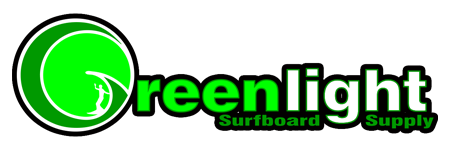A freelap is common on clear boards where you simple saturate the fiberglass and squeegee it onto the opposite side of the shaped blank. When the resin cures the edge of the fiberglass is sanded flush, or close to flush with the foam. Be careful when sanding not to hit the foam. A nice sanded flush lap will prevent air bubbles along the 'lap line' when laminating the deck.
A cutlap is commonly used when adding resin tint or pigment to the laminating resin. If glassing the bottom of the board, the lap on the deck is first taped off on with masking tape along the outline of the board, about 1“ to 1 ½" in from the apex of the rail. The tape defines the 'lap line' and prevents resin and fiberglass from sticking to the board where the tape is. Saturated fiberglass is squeegeed around the rail and onto the tape. When the resin gels or 'kicks', a sharp razor blade is used to cut the fiberglass along the tape line. The excess fiberglass that is stuck to the tape is then peeled off the blank (along with the tape) leaving a nice straight cut lap line around the board. This lap line can be gently pushed into the board with a popsicle stick instead of sanding it flush. Cutlaps are mostly covered with a pinline on the hotcoat to hide a wobbly cut.
